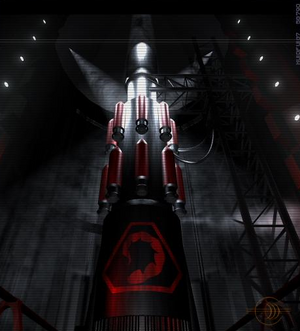
The Temple of Nod houses WMD launch facilities.
The concept of a "Weapon of Mass Destruction" has been around for quite some time; however, only in the twentieth century did military technology progress to the point that weapons capable of instantly killing large groups of enemy personnel with little risk to the wielder could be developed.
First Tiberium War[]

GDI Ion Cannon strike.
By 1995, GDI had discretely developed the Ion Cannon, an orbital satellite weapon that could be used as an unstoppable surgical tool of destruction. Kane was thought to be dead when GDI forces used their Ion Cannon on the Temple of Nod in Sarajevo. The GDI developed a man-placed target designator for Ion Cannon strikes called GS-2 Godsend Ion Cannon beacons, and used it effectively in various situations.
Meanwhile, Nod forces had managed to procure large amounts of fissile material, and the scientific expertise required to effectively use them. Nod Temples served as ICBM launch facilities that housed nuclear warheads far more powerful than their Soviet predecessors. GDI member nations also held stockpiles of nuclear weapons, but swore not to use them, even if their enemies did. Nod developed a man-placed target designator for nuclear-tipped ICBM strikes called the "Retribution", and used it effectively in various situations, sending high yield warheads with pinpoint precision from Temples, trucks and submarines with full-fear red sky effect using a secret device.
Second Tiberium War[]

The WAM resting in its silo
GDI upgraded and expanded the Ion Cannon network, although they functionally remained similar to the older 'surgical strike' weapon.
Nod largely abandoned its nuclear arsenal, choosing to use the air burst Multi missile, which would fragment into many smaller bomblets in mid-air. Also, Nod invented the Chemical missile, which utilized the processed roots of the Veinhole monster, and would release deadly Tiberium gas upon striking a target. However, Nod did still use its smaller, 'tactical' nuclear weapons to destroy the island playing host to General Vega.
One superweapon that Nod invented was the World Altering Missile. Kane used it to mutate all carbon-based life worldwide into Tiberium life in the alternate Nod campaign.
CABAL's massive Core Defender could in some ways be considered a superweapon, as it was bordering on indestructible and had unparalleled firepower, though its inability to attack air targets proved its Achilles' heel.
Third Tiberium War[]

Rift Generator charging
GDI's Ion Cannons received a significant update by 2047. Now capable of large scale destruction, utterly annihilating anything from entire military bases to small cities, GDI relied heavily upon the threat of death from the skies to keep Nod in check. This over-reliance nearly proved fatal, however, when after the destruction of Goddard Space Center the Ion Cannons were temporarily rendered inoperable, and Nod was able to begin a global offensive with little fear of retribution.
Nod had once again started to stockpile nuclear weaponry, launched from the Temple of Nod. The nuclear missile that destroyed the GDSS Philadelphia was launched from a concealed base in Cairo. Though GDI managed to confiscate these stockpiles following the conquest of Egypt, Nod stole GDI nuclear warheads in the Australian Outback.
Nod also developed the Liquid Tiberium Bomb, a weapon that had a minimal blast yield several hundred times greater than that of a nuclear warhead. Worse, it would cause a chain reaction with any Tiberium in the blast radius, increasing the explosive power by an order of magnitude. GDI accidentally set off this device when an Ion Cannon was used during the Siege of Temple Prime. GDI Director Redmond Boyle commissioned the construction of another Liquid Tiberium Bomb, and authorised its use during the Battle at Ground Zero.
The Scrin were attracted to Earth by the Liquid Tiberium Bomb, and brought along their own superweapon, the Rift Generator. It alters the fabric of time and space, creating a singularity in a targeted area. In other words, anything in the radius of destruction would be sucked into a temporary, artificial black hole. The Scrin Mothership also appeared to be a superweapon, its powerful Catalyst cannon being able to destroy entire military bases (and even cities) in an impressive chain reaction.
Fourth Tiberium War[]
Superweapons are still in use in the Final Tiberium War. However, the Ion Cannon can now fire a (weaker) blast when not fully charged, and the Temple of Nod can launch a weaker missile sooner instead of the more powerful one. Only the Defense class can construct superweapons.
Although if left to charge all superweapons become lethal to all enemies.
Drawbacks[]
All superweapons take a long period of time to re-use, especially the TWIII era superweapons such as the Ion Cannon and Rift Generator.
Without power, Superweapons cannot be used.
When the Superweapon is deployed the enemy is more likely to put the superweapon as their first target in a retaliatory strike.
Certain Scrin Powers can protect their units from the damage caused by Superweapons, and if the MARV, Eradicator Hexapod and Redeemer units are at full health, they won't be killed from the Superweapon's effects.
Often, constructing a superweapon's associated support facility (ie, Missile silo, Ion Cannon Control Center, etc.) reveals an area around it to everyone. It is very difficult to keep them from being detected even with Nod disruption towers, and their launch usually comes with some form of warning as well (if the target is correctly predicted, the target could be moved, or protected from damage in some way.)
Most superweapons cost $5000 and are hard to get.
